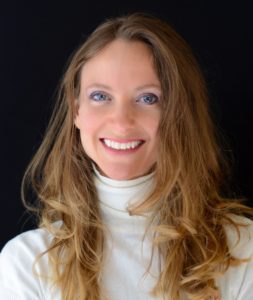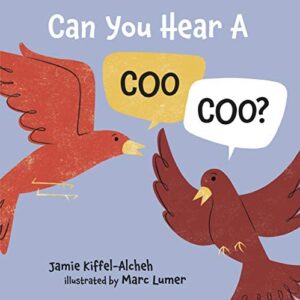There is no doubt that the greatest gift of being in the world of children’s literature is the community of writers, illustrators, and other creative people who share a passion for the work we all do. Every so often, you cross paths with someone who is meant to be in your life. That’s how I feel about Jamie Kiffel-Alcheh. We first met at an SCBWI Summer conference, and again at a few local events. Coincidentally, we both became involved with PJ Library. Our worlds have collided in so many wonderful ways. Jamie’s talents are endless and her dedication to her work is inspiring. I’m delighted to share the story of her success.
Your journey to publication for your first book, CAN YOU HEAR A COO, COO? was an exciting process. Can you share a bit about it?
When I started submitting children’s manuscripts, I quickly learned that there were a lot of industry rules in place, and I was afraid to break them. I like rules. And I think that a part of me likes to feel that if something I’ve tried isn’t working out, then it’s out of my hands because I was following the rules and so I guess I don’t have to take a big chance and break a rule. It’s a type of excuse for not succeeding. As it turned out, once I started breaking rules, everything changed. I now know that one could also call judicious rule-breaking “thinking more creatively,” or “acting like a maverick.”
Rule 1: Don’t pitch with an illustrator already attached. I have been told this so many times, even by really big published authors who claim that they could approach their publisher with a famous illustrator on board, and that it wouldn’t help their cause. Or even that the publisher would be turned off by their offer to team up with an art superstar. Well, I met illustrator Marc Lumer through Friendship Circle LA, which is a Jewish group that supports parents of children with special needs (of which I am one). Marc had illustrated and authored a number of successful children’s books, including BABEL and BENNY’S MITZVAH NOTES. He’d also worked for Dreamworks and Disney TV Animation. He’d wanted to get a book into Kar-Ben (the Jewish division of Lerner Publishing), and so had I. He’d also wanted to get a book into PJ Library, which is a charitable program from the Harold Grinspoon Foundation that sends out nearly 600,000 children’s books a year to Jewish families nationwide. And so had I! He told me he had some “orphaned” illustrations on his website. “If you see something that inspires you, maybe you could write a story around it,” he said. I found some illustrations of animals that reminded me of Indonesian paper cut-outs. I started writing a story about Noah’s Ark. I read Marc version after version, and he gave me feedback until I’d pared it down to its essential elements. Which brings me to Rule 2…
Rule 2: Don’t write in rhyme. The unspoken industry caveat to this is “unless you can do it well.” If you feel like you can do something well, don’t listen to naysayers! When I started writing children’s books, my daughter was two, and I was studying rhyme every day—extra intensively, in fact, because she was born with a neuromuscular condition that makes it very hard for her to talk. I’d been to hundreds of speech therapy sessions with her, all of which incorporated children’s books. I learned that three essential elements make it easier for all kids’ brains to learn language: rhyme, rhythm, and repetition. I used these in my book, CAN YOU HEAR A COO, COO? I also used the invaluable poetry-writing advice I’d learned from my college professor, Frank Bidart. (Prof. Bidart won a Pulitzer this year!) Prof. Bidart taught me to let the poem take control, and not to force it to be what I want it to be. Even in children’s literature, I realized this is important. I do have a firm rhyme scheme, but it is a major departure from what I’d originally written. I wound up deconstructing the text until the words could pop with simplicity and onomatopoeia.
Rule 3: Don’t pitch directly to the publisher. Get an agent! Well, I was pitching to agents, but my lobs seemed to be flying into the outfield. So first, I used Marc’s referral to Kar-Ben publisher Joni Sussman. But she didn’t respond. So next, I went to The Manuscript Wish List. And I found Joni on there! I pitched to her through the wish list, and lo and behold…one week later, I received an email that started, “We’d like to publish…” I raced through the house screaming, “EEE”! while my daughter looked on in amusement.
An important note: Marc did not pre-illustrate the book. We submitted three of his illustrations as samples. And they are not the same illustrations that ended up in the book; the originals were inspirations. So, assuming a successful sale, the worst that could have happened is that Joni didn’t want his illustrations but did want my text, or that she didn’t want my text, but wanted his illustrations for another book.

You have new books coming out! How did the creative and publishing processes differ from the first book?
Marc became an even bigger star than he already was: he was hired to set up and head GreenGold USA, the American branch of GreenGold Animation, one of the biggest animation studios in India. The Studio is currently in production on a show for Netflix and another one for Amazon. Marc also sold his book AMERICAN GOLEM and is currently working with his studio on adapting it as a feature animated film. So Marc became extremely busy, and the publisher assigned different illustrators to my next books (though Marc and I do plan to work together again). But I did get to see the new books’ artwork while it was in process, and give feedback such as, “Hey! I pictured this going from morning to night, but the panels show different times of day throughout. Can we change that?” And “This is exactly what I was picturing when I wrote the text. Did you read my mind? I am overjoyed!”

You balance a number of creative roles – author/poet, journalist, lyricist. How do you find time to do it all?
My mom always says, “You can do everything, just not all at the same time.” Some days, I’m writing. Some days, I’m editing. Saturdays, I’m doing yoga! Every day, I’m caregiving for my daughter. I work on writing, reading, pitching and marketing while she’s in preschool (three hours in the morning); during the afternoon when I have a babysitter (three more hours), and sometimes at night, but lately, I’ve been spending the night hours studying Hebrew on Duolingo.
Where do you find inspiration for your books?
My kid, her friends, my memories, peak experiences (in Abraham Maslow’s words). At Yom Kippur, I took my daughter to a Yom Kippur children’s service. I didn’t know that type of service was possible. Yom Kippur may be the holiest day in the Jewish calendar, but it’s also the darkest—it’s the Day of Atonement. The surprisingly joyful children’s service inspired me to write a book about Yom Kippur for preschoolers. I look for topics and structures that are at once exciting and very difficult. I want to do what I’m uniquely skilled to do—the hardest and best I can achieve.
Thank you, Jamie!
To learn more about Jamie and all of her creative endeavors, please visit her website Jamie Kiffel-Alcheh.
2 thoughts on “Welcome – Jamie Kiffel-Alcheh”
Comments are closed.